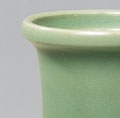J.J. Lally & Co., Oriental Art / New York City, New York
MenuPast Exhibition
The Gordon Collection:
Chinese Ceramics and Works of Art
March 12 - April 4, 2009
22.
A LONGQUAN CELADON VASE
Southern Song Dynasty (A.D. 1127-1279)
of pear shape with steeply sloping shoulders rising to a wide cylindrical neck and wide mouth with rounded, galleried rim, standing on a slightly tapered ring foot, the glaze of attractive bluish-green color showing an even tone all over, draining to a paler hue at the lip rim and pooling to a more intense color inside the mouth, the unglazed edge of the footrim burnt to a pale russet tone in the firing.
Height 5 7⁄8 inches (15 cm)
Published:
Mowry, ‘Chinese Ceramics from the Collection of Dr. and Mrs. Marvin L. Gordon,’ Orientations, March 2004, fig. 5, p. 118
A similar Longquan celadon vase excavated in 1963 from the tomb of Ren Xi Qing, dated A.D. 1213, discovered at Wuhan, Hebei province and now in the collection of the Hubei Provincial Museum, is illustrated in Kaogu, 1964, no. 5, pp. 237-240; the same vase is illustrated in Longquan Yao Qingci (Celadons from Longquan Kilns), Taipei, 1998, no. 109, p. 142.
Compare also the Longquan vase of this form in the Meiyintang Collection, formerly in the Collections of Edward Chow and Mrs. Alfred Clark, illustrated by Krahl in Chinese Ceramics from the Meiyintang Collection, Volume One, London, 1994, no. 555, p. 296. Another Longquan vase of this form in the Musée Guimet, from the Michel Calmann Collection, was exhibited at the National History Museum in Taipei in 1999 and illustrated in the catalogue entitled Terre de Neige, de Glace, et d’Ombre, no. 33; and the same vase was previously illustrated in the exhibition catalogue Collection Michel Calmann, Musée Guimet, 1969, no. 13, p. 47. Similar vases in the Kempe Collection are illustrated by Gyllensvard in Chinese Ceramics in the Carl Kempe Collection, Stockholm, 1964, nos. 96 and 97, p. 50.
南宋 龍泉青瓷長頸瓶 高 15 厘米
